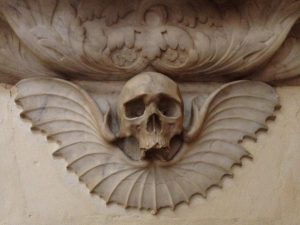
The OGOM Project is known for its imaginative events and symposia, which are often accompanied by a media frenzy. We were the first to invite vampires into the academy back in 2010. Our most recent endeavour, Company of Wolves: Werewolves, Shapeshifters and Feral Humans enjoyed extensive coverage globally and saw us congratulated in the THES for our ambitious 3 day programme which included actual wolves, ‘a first for a UK academy’. Our fourth conference will be an exciting collaboration with the Supernatural Cities: Narrated Geographies and Spectral Histories project at the University of Portsmouth. Supernatural Cities will enjoy its third regeneration, having previously convened in Portsmouth and Limerick.
The Open Graves, Open Minds Project unearthed depictions of the vampire and the undead in literature, art, and other media, before embracing shapeshifting creatures (most recently, the werewolf) and other supernatural beings and their worlds. It opens up questions concerning genre, gender, hybridity, cultural change, and other realms. It extends to all narratives of the fantastic, the folkloric, the fabulous, and the magical. Supernatural Cities encourages conversation between disciplines (e.g. history, cultural geography, folklore, social psychology, anthropology, sociology and literature). It explores the representation of urban heterotopias, otherness, haunting, estranging, the uncanny, enchantment, affective geographies, communal memory, and the urban fantastical.
The city theme ties in with OGOM’s current research: Sam George’s work on the English Eerie and the urban myth of Old Stinker, the Hull werewolf; the Pied Piper’s city of Hamelin and the geography and folklore of Transylvania; Bill Hughes’s work on the emergence of the genre of paranormal romance from out of (among other forms) urban fantasy; Kaja Franck’s work on wilderness, wolves, and were-animals in the city. This event will see us make connections with the research of Supernatural Cities scholars, led by historian Karl Bell. Karl has explored the myth of Spring-Heeled-Jack, and the relationship between the fantastical imagination and the urban environment. We invite other scholars to join in the dialogue with related themes from their own research.
From its inception, the Gothic mode has been imbued with antiquity and solitude, with lonely castles and dark forests. The city, site of modernity, sociality, and rationalised living, seems to be an unlikely locus for texts of the supernatural. And yet, by the nineteenth century, Dracula had already invaded the metropolis from the Transylvanian shadows and writers such as R. L. Stevenson adapted the supernatural Gothic to urban settings. Gaskell, Dickens and Dostoyevsky, too, uncover the darker side of city life and suggest supernatural forces while discreetly maintaining a veneer of naturalism.
In twentieth-century fantastic and Gothic, perhaps owing in part to a disillusionment with modernity, all manner of spectres haunt our cities in novels, film, TV, and video games. Radcliffean Gothic saw the uncultivated wilderness and the premodern past as the fount of terror; the contemporary fantastic discovers the supernatural precisely where space has been most rationalised—the modern city. Civilisation, rooted etymologically in the Latin civitas (‘city’), is itself put into question by its subversion by the supernatural.
Supernatural cities emerge in a range of contemporary fictions from the horror of Stephen King to the dark fantasy of Clive Barker, the parallel Londons of V. E. Schwaab and China Mieville, magical neo-Victorian Londons in the Young Adult fiction of Genevieve Cogman and Samantha Shannon, and Aliette de Bodard’s fallen angels and dragons in a supernatural Paris. In TV, there is the vampire-ridden noir LA of Angel. The large metropolises are not alone in their unearthliness—see the Celtic otherworld that lies behind Manchester in Alan Garner’s Elidor. Then there are the imagined cities of high fantasy, which form a contrast to the gritty familiarity of the cities that feature in the distinct genre of urban fantasy itself or the frequently urban backgrounds of paranormal romance. Supernatural cities are haunted, too, by such urban legends as Spring Heeled-Jack and Old Stinker, the werewolf of Hull.
The conference will explore the image of the supernatural city as expressed in narrative media from a variety of epochs and cultures. It will provide an interdisciplinary forum for the development of innovative and creative research and examine the cultural significance of these themes in all their various manifestations. As with previous OGOM conferences, from which emerged books and special issue journals, there will be the opportunity for delegates’ presentations to be published.
Keynote Speakers:
Prof. Owen Davies, historian of witchcraft and magic, on ‘Supernatural beliefs in nineteenth-century asylums’
Dr Sam George, Convener of the Open Graves, Open Minds Project, on ‘City Demons: urban manifestations of the Pied Piper and Nosferatu Myths’
Adam Scovell, BFI critic and Folk Horror film specialist, on ‘the Urban Wyrd’
Dr Karl Bell, Convener of the Supernatural Cities project, on ‘Spectral Histories: the fantastical imagination and the urban environment’ ( title tbc)
Delegates will engage with our Gruesome Gazetteer of Gothic Hertfordshire and accompany us on a tour of Supernatural St Albans and its environs.
Look out for the CFP… coming in a few days time!!!

